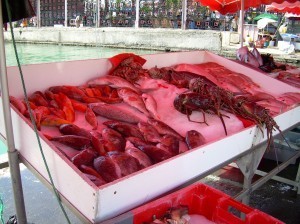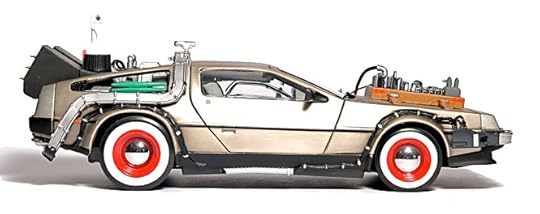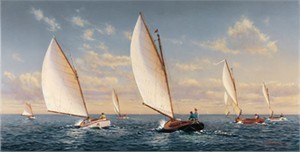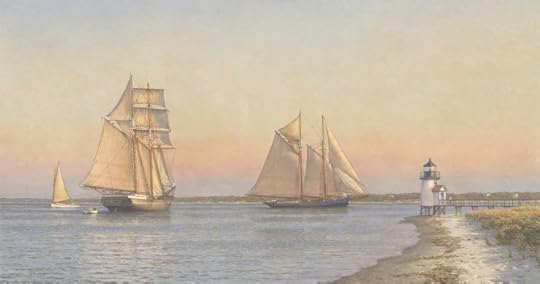Mike Jastrzebski's Blog, page 73
December 27, 2011
The Contrast of Holidays
Ye shall love peace as a means to new war, and the short peace more than the long – Nietzsche "Thus Spoke Zarathustra"
I never felt more in tune with this quote than after the worst passage of my life. The pain of the battering waves and wicked winds sustaining 30 to 40 knots was insufferable and seemed to have no end. Once ashore, the memories of the adventures during the trip, the war to survive, made me long to escape the peace ashore. Adventures are a funny thing. They are painful during but with time make you long to venture again and suffer once more.
Holidays are similar. After months of warring at work, the rest of holidays is so welcome. But then you remember the excitement of life and venture out again to engage in the world in some misdirected fashion.
War itself has a strange significance to those who have experienced it. Elders tell never-ending stories of danger and destruction while in the military. It is not politically correct, but you sense they do not regret their time but in some ways cherish the wartime adventures.
I think it is the contrast between suffering and safety that characterises much of what people romanticise. These adventures are not pleasurable in themselves, but there is a surge of pleasure when they end. It is like pressurising your enjoyment into a sudden burst.
When I finish the suffering of writing an article or story, I experience the same sensation of safety and soon remember back on the mental adventures that I travelled through. I look towards the next writing war and how through it my thoughts will develop.
Here's to many new offshore and internal adventures to all in 2012.
Share on Facebook
December 26, 2011
Celestial 48
By Zuzana Prochazka
The Celestial line of light to moderate displacement center cockpit cruisers is from Xiamen Celestial Yachts originally based in Hong Kong, China. These rare boats have a long history, but many of the details are murky or downright inaccurate. Today, you may see their design attributed to anyone from Sparkman & Stevens to Ted Brewer or Robert Perry. After some digging and email exchanges with Messrs. Perry and Brewer and with S&S, I learned that Bryce Fuhriman based his first boat, a 46, on a Brewer design and added his own changes. He then put together an international team of American ownership, Australian management and Chinese craftsmanship to build this line of semi-custom bluewater boats destined for the North American market. But he started his venture in 1980 and the next five years proved to be difficult in terms of generating sufficient funds and fighting a troublesome market in the US. Fuhriman experimented with several sizes including 43s, 44s, 46s, 48s and 56s. By 1985, the line mainly focused on the 48 foot ketch.
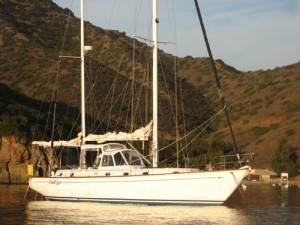
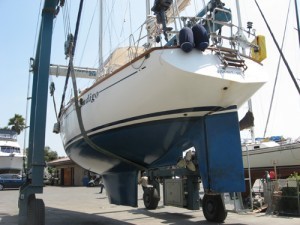
The 48 has a fully encapsulated, elongated fin keel consisting of two solid lead castings. The skeg hung rudder is very large and should be checked for water at haul out. The 48 underbody is very full and round which makes her heel to a certain point rather quickly, but then the 44% ballast to displacement ratio takes over and she stabilizes and picks up and goes. At the sea trial, we were thrilled to see her move like a luxury car with only 8-10 knots across the deck and we've often seen her do 9 knots in an 18 knot breeze.
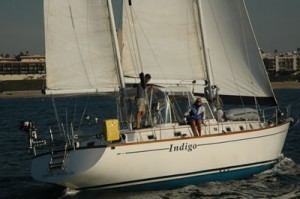
The hull of the 48 is balsa cored with reinforcement at the chainplates, rudder shaft and propeller shaft. The balsa is cut away and sealed with epoxy around the through hulls and is omitted entirely in the keel sides and on the centerline. Like Indigo, most of these boats came from the factory with teak decks which some owners have since replaced with glass and nonskid.
The 48 has substantial bulwarks for good footing offshore and strong hawse holes that minimize chafe on the teak caprail. However, beware the placement of the scuppers which seem to miss the bulk of the water traveling down the gunwales and therefore standing pools form on the decks.
Cockpit, Deck & Rigging
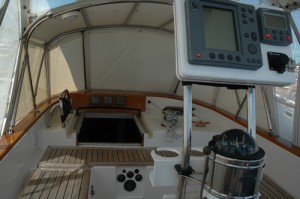
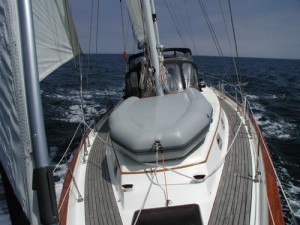
Indigo's sail area is a little less than the original 990 square feet since her boom was raised to make room for a full-sized bimini. The Celestial 48 was designed as a ketch with a keel stepped double spreader rig. When examining these boats, be sure to check the condition of the mast step. Indigo's mast step was basically a large chunk of wood encased in fiberglass that had rotted due to a leak from the forward fresh water tank and the mast had sunk enough to make the standing rigging slack.
Although high, the masthead rig is not overpowering since it is a split rig with a mizzen that is surprisingly large for a ketch. This is not the usual mizzen boom on which to dry laundry. The 48 does quite well on a beam or broad reach under a jib and jigger configuration, running comfortably and on her feet at 8 knots or higher.
Indigo's mainsheet was originally led forward and then back to the cockpit much like on an aft cockpit layout. However, this did not let the helmsman have easy control, especially if singlehanding. Unfortunately, given the ketch rig, there is no convenient place to install a mainsheet winch so we added a 4:1/16:1 cascading purchase to control and fine tune the mainsail trim which works well.
The cockpit is compact and trimmed with teak. There is great additional storage beneath both port and starboard seats and plenty of room for instruments under the dodger. There are two aft lazarettes which make for a fantastic garage.
Layout & Accommodations
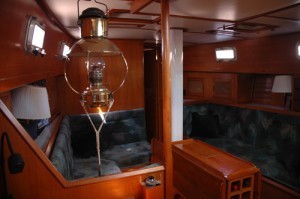
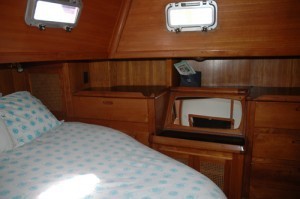
The Celestial layout is a modern fore and aft cabin design that features 6'4" headroom. The spacious interior begins with a 6'6" vee-berth forward followed by a head and shower combination to port. The saloon has a centerline drop-leaf table with a built-in eight bottle wine rack and settees along either side. The galley is to starboard and the main complaint here is limited counter and drawer space but food storage space is good. The sinks are near the centerline and close to the companionway steps so the cook doesn't have to go far to get food to the crew in the cockpit.
The forward facing nav station sits at the beginning of the passageway that leads aft on the port side with door access to the crawl-in engine room. Originally, some of the 48s had a separate freezer outboard of the passage but many owners removed the freezer and replaced it with a voluminous storage compartment that houses all the tools and spares, a handy feature as it is directly across from the engine room. A wet locker is near the companionway which has a built-in locker in each step. The entire boat has a spectacular teak interior with 23 hand-caned lockers that provide incredible storage. Ventilation is provided by fifteen opening ports and seven opening hatches.
The luxurious owner's suite aft on the 48 came in a variety of layouts but primarily there is a king-sized centerline bunk which allows sleeping fore and aft or athwartships which is handy in a seaway. The aft head has a dedicated (not a walk-through) separate shower. Another nice feature is that the emergency tiller attaches on deck unlike many center cockpit boats that feature it under the aft bunk, so emergency steering allows for good visibility.
Systems & Mechanical
The 48 has a dedicated, well-insulted and well-lit, crawl-in engine room that allows access to all sides of the 62HP Perkins 4-154. Many of these boats originally came with 62 HP Lehmans as well. One thing to check with the 48s is the bonding system. Our copper stripping had been disconnected in several places leaving us with electrolysis issues. One of the problems that caused was wear on the prop which was replaced with a 3-blade Maxprop after survey.
The anchor locker allows for the chain to slip down and below the vee-berth thereby pushing much of the weight lower and farther aft. On deck, there is a substantial opening compartment into the anchor well which allows for storage of docklines and other smaller objects. The bow roller is a bit undersized for a yacht of this class and we will be upgrading Indigo's to bring the anchors farther forward and away from the hull.
Tankage on these boats is phenomenal. Originally, the Celestial 48s were spec'd with 250 gallons of fuel and 250 gallons of fresh water. All the tanks are fiberglass, on the centerline beneath the cabin sole. However, many owners requested different tank configurations so you may want to investigate the actual capacity on any boat you view. The 48s were built with a minimal number of through hulls which is good from the perspective of having fewer holes in the boat. It does mean however, that grey water is stored in the sump and then pumped overboard. This means that the cook must be extra zealous in wiping off dishes before actually washing the rest of the debris into the sump.
Wrap Up
Celestials are still built today. The 48s are now sloops and cutters and are primarily sold in the European market. Several brokerages import the new 50s which are also sloops but have added a very large deck house that creates the look and feel of a tall motorsailor. If you look closely at the hull shape however, you'll still see the same lines as the 48, graceful, clean and powerful.
At press time, there are four Celestial 48s listed on Yachtworld and their price ranges from $130,000 to $220,000 for mid-eighties models. A 1985 boat in average condition would have a BUC value of around $160,000. Since so few of the old 48s were built, the relative obscurity of these vessels depresses the market price for this class of boat which means there is a tremendous amount of value to be picked up by anyone looking for a serious bluewater boat that can take you extended cruising just about anywhere.
Specs for Celestial 48 Ketch
Designer: Bryce Fuhriman et alLOA: 48'0"
LWL: 39'4"
Beam: 13'6"
Draft: 6'
Ballast: 11,800 lbs
Displacement: 27,000 lbs
Sail Area: 990 sq ft
Fuel Tankage: 250 gallons
Water Tankage: 250 gallons
Ballast/Disp 44%
Disp/Length 198
SA/Disp 17.67
Zuzana Prochazka. Zuzana is a freelancer and a regular contributor to Sea Magazine, SAIL, Latitudes and Attitudes, Lakeland Boating, Yachtworld and Boats.com. Her work has appeared in Santana, Voyaging, Good Old Boat, Reeds Nautical Almanac, and the Los Angeles Times Sunday Magazine, as well as online at underwatercolors.com, sailingbreezes.com, catamarans.comand floridascubanews.com. She is president of Boating Writers International (BWI) and has served as Innovation Awards judge at the IBEX, Miami, and MAATS shows for several years. Currently, she serves as the chairperson for the BWI New Products Committee and as a judging chair for the BWI Annual Writing Contest. Zuzana's gear and boat review blog is TalkoftheDock .
Share on Facebook
December 24, 2011
Merry Christmas From Mike and Mary Jastrzebski (and Belle)
December 22, 2011
Caribbean Christmas stories

Creole market lady in Point-à-Pitre, Guadeloupe
by Christine Kling
Holidays are a time for nostalgia. We remember the stories of holidays with our parents, our ex-spouses, our own kids now grown – or, in the case of this writer who just published a book I spent FIVE YEARS writing, I've been thinking back to the first Christmas I spent working on this book.
On Christmas day, 2006, I flew from Miami to Point-à-Pitre, Guadeloupe to start research on a book I wanted to set in the waters around that island and Dominica to the south. During the next ten days, my friend Bruce and I explored the islands, and the experiences I had, as well as the photos I took, helped shape the story that was yet to be born.
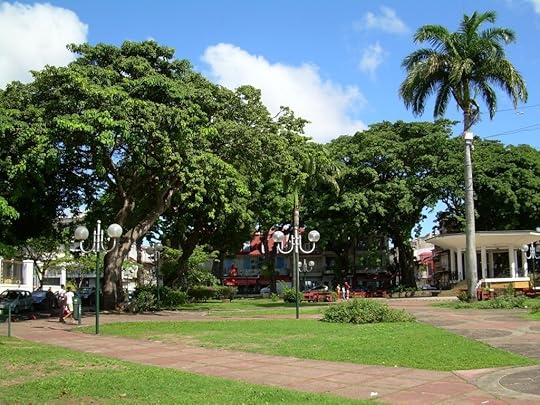
Place de la Victoire, Point-à-Pitre where Diggory Priest spots Riley
I have always found that photos of my locations help me to write those scenes vividly.
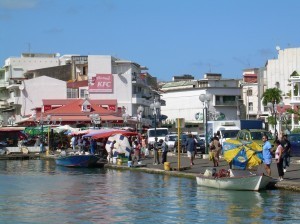
Point-à-Pitre waterfront
When I had Riley bring the immigration agent ashore in her dinghy, she tied her dinghy along this seawall.
She noticed the red squirrel fish in the white plastic buckets along the waterfront because I had taken a memorable photo of such fish myself.
Even though I was often revising and rewriting scenes years after I had visited these places, the photos helped me to come up with those great little details that help make the reader feel like he is living and breathing in the scene.
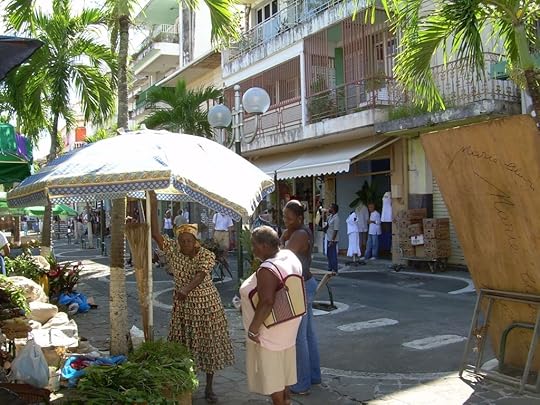
Point-à-Pitre unique architecture
When Bruce and I arrived during the Christmas holidays, we only had one night's reservation at a small hotel downtown. The place had more than bars on the windows – there was a fence around the balcony, and the desk clerk was behind a glass window.
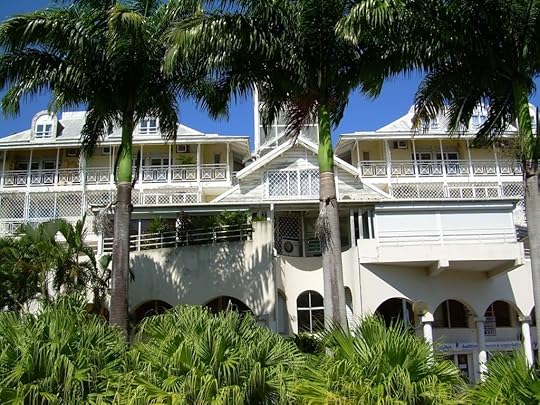
Point-à-Pitre Hotel
When you combined that with the fact that we didn't see a single other American in the city, we could have come away with the idea that it was a scary, dangerous city. However, due a year spent in France as a foreign exchange student, I speak passable French, and we met and talked to some very nice people. Guadeloupe is a department of France, so you are in France, just as you are in the US when you go to Hawaii.
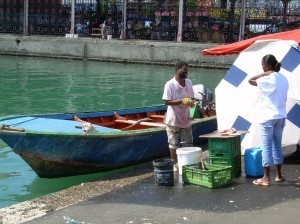
People on Guadeloupe were great
Since we had no reservations and it was Christmas, we went to the tourist bureau on December 26th, and we managed to get ourselves rooms for the rest of our stay, however the lady there did look at us like we were daft. The thing is, though, we ended up staying in little local places that we never would have been able to book from the states.
I wanted to see the islands the way my characters would have seen them when they were in crisis and having to deal with getting from place to place without reservations in American-like resort hotels. The plan worked great, and it made for a remarkable and memorable visit island-style.
And now I've come full circle, so to speak, and five years later, my dream has come true and I've released that novel just in time for the Christmas holiday in 2011. I spent last weekend in formatting hell, but the book is now available on Kindle and Nook and I hope to have it out on all the other platforms in a couple of weeks. I'm aiming to have the print version out by February.
I could not think of a better Christmas gift for myself than to see the book finally available for sale. Wait, maybe I could. I suppose it would be even better to sell a few 
Happy Holidays to all the readers of Write on the Water, and here's my wish that this Christmas holiday helps produce great stories for all of you.
Fair winds!
Christine
Share on Facebook
Christmas stories

Creole market lady in Point-à-Pitre, Guadeloupe
by Christine Kling
Holidays are a time for nostalgia. We remember the stories of holidays with our parents, our ex-spouses, our own kids now grown – or, in the case of this writer who just published a book I spent FIVE YEARS writing, I've been thinking back to the first Christmas I spent working on this book.
On Christmas day, 2006, I flew from Miami to Point-à-Pitre, Guadeloupe to start research on a book I wanted to set in the waters around that island and Dominica to the south. During the next ten days, my friend Bruce and I explored the islands, and the experiences I had, as well as the photos I took, helped shape the story that was yet to be born.

Place de la Victoire, Point-à-Pitre where Diggory Priest spots Riley
I have always found that photos of my locations help me to write those scenes vividly.

Point-à-Pitre waterfront
When I had Riley bring the immigration agent ashore in her dinghy, she tied her dinghy along this seawall.
She noticed the red squirrel fish in the white plastic buckets along the waterfront because I had taken a memorable photo of such fish myself.
Even though I was often revising and rewriting scenes years after I had visited these places, the photos helped me to come up with those great little details that help make the reader feel like he is living and breathing in the scene.

Point-à-Pitre unique architecture
When Bruce and I arrived during the Christmas holidays, we only had one night's reservation at a small hotel downtown. The place had more than bars on the windows – there was a fence around the balcony, and the desk clerk was behind a glass window.

Point-à-Pitre Hotel
When you combined that with the fact that we didn't see a single other American in the city, we could have come away with the idea that it was a scary, dangerous city. However, due a year spent in France as a foreign exchange student, I speak passable French, and we met and talked to some very nice people. Guadeloupe is a department of France, so you are in France, just as you are in the US when you go to Hawaii.

People on Guadeloupe were great
Since we had no reservations and it was Christmas, we went to the tourist bureau on December 26th, and we managed to get ourselves rooms for the rest of our stay, however the lady there did look at us like we were daft. The thing is, though, we ended up staying in little local places that we never would have been able to book from the states.
I wanted to see the islands the way my characters would have seen them when they were in crisis and having to deal with getting from place to place without reservations in American-like resort hotels. The plan worked great, and it made for a remarkable and memorable visit island-style.
And now I've come full circle, so to speak, and five years later, my dream has come true and I've released that novel just in time for the Christmas holiday in 2011. I spent last weekend in formatting hell, but the book is now available on Kindle and Nook and I hope to have it out on all the other platforms in a couple of weeks. I'm aiming to have the print version out by February.
I could not think of a better Christmas gift for myself than to see the book finally available for sale. Wait, maybe I could. I suppose it would be even better to sell a few 
Happy Holidays to all the readers of Write on the Water, and here's my wish that this Christmas holiday helps produce great stories for all of you.
Fair winds!
Christine
Share on Facebook
Back to the Future…
C.E. Grundler
I think I've uncovered a way to alter the flow of time, though I'm certain I can't be the first to encounter this weird anomaly. After months of intensive, nearly non-stop writing, I've reached the end – for the moment at least. No Wake Zone is now in the hands of my editor. And as I wait for the verdict on how it reads and what inevitably will need attention, I was given strict instructions to step away from the computer. That was last Saturday and that was also the point when I realized, much to my astonishment, that Christmas was one week away. You have to understand, while time continued to pass at a normal rate for the rest of the world, my reality has remained fixed in September. That's when everything was happening in my fictional world, coming together and falling apart all at the same time. Occasionally I'd look up from the keyboard, and I'd notice almost as an aside that the leaves had changed from green to gold to gone, and that boats were coming out of the water and crowding in around us on the hard. The sun's been rising later and setting earlier and the temperature has dropped too much to work with epoxy, which once again has brought a halt to boat work. Still my brain remained stuck in September — until last weekend, that is.
Now I'm at loose ends. I'm not quite sure what to do with myself, though truth is I have plenty of catching up to do here in reality. It's holiday season, and I have *just* enough time to do the necessary last minute rush around shopping. There's that situation with the tire on my car; I took care of that yesterday. There are plenty of odds and ends around the house clamoring for my attention, not to mention a stack of books I've been waiting for some free moments to read. Still, I can't seem to shake this strange disorientation, as though I've been cast out of place and time. But I'm not concerned; I'm sure just as I get past this odd jet lag, my editor will put me on the next DeLorean straight back to September.
And a Happy Yule to all!
Share on Facebook
December 20, 2011
Homer's "Sailing the Catboat"
Holiday shopping, end-of-the-year tasks, over-scheduled days – yes, 'tis the season. With that in mind today's blog takes a bit of a detour. My goal remains true: a focus along the water with a dose of escapism and maybe some levity along the way, but today's vehicle is the canvas more than the page. With this in mind, let's take advantage of the wonderful flexibility of blogs and explore the saltwater escapism offered by maritime artists.
You want to make your way south to the Bahamas, set sail and head off with friends just as you might have done in your youth? It might be contemporary thought, but Winslow Homer beat you to it by more than a hundred years. A generation ago, my dad kept a small, reproduced copy of this painting on his work desk. He wasn't the first or last, and with good reason.
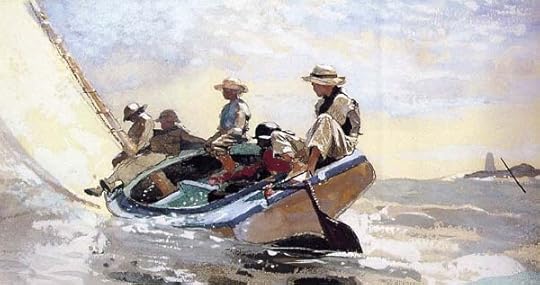
(SAILING THE CATBOAT by Winslow Homer, 1836-1910)
Some years ago I met Michael Keane when his black sandbagger, which looks very similar to the one in the image below, was being finished in a boat shop alongside my own sailboat. His works sell very well, and if you examine one, you will know why.
Don Demers grew up in Massachusetts, but he has deep roots in Maine. His paintings reveal the care and authority that comes from time at sea. View Scalloping off Nantucket for a few moments and you can feel the biting chill in your hands.
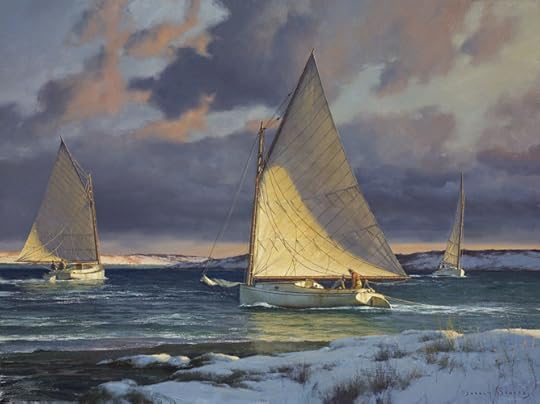
(Scalloping off Nantucket, Don Demers)
Or take a look at Richard Loud's detailed capture of the era of sail.
But you can also have some fun along the way, which brings me to a New England maritime artist by the name of David Witbeck.
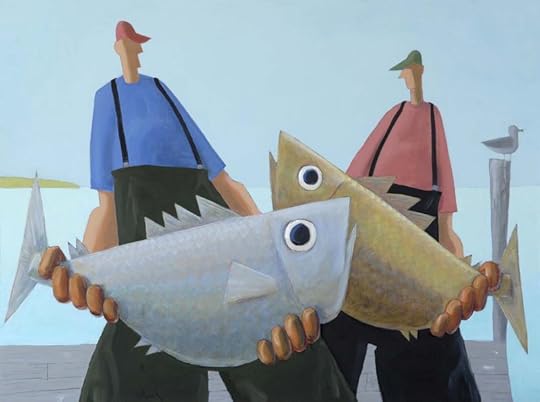
(Toby and Patrick by David Witbeck)
I envy the way Homer, Keane, Demers, Loud, and Witbeck capture the world along the water. I admire them all and in some way their individual works likely influence my attempts to capture a sense of place.
I hope you enjoy their work, as well.
And with this, I close by signing off for the year wishing everyone a safe holiday season filled with cheer, warm cider, spiked egg-nog, and safe travel.
Oh, and e-readers.
Don't forget the e-readers.
Share on Facebook
December 19, 2011
Hemingway called it 'Black Ass'
If you've followed my blog, you know that I just finished my current Mick Murphy Key West Mystery. I was a month behind a self-imposed deadline. The editor took the first three-quarters of the book and bugged the hell out me waiting for the rest. She finally got it (and never had the decency to thank me, only bill me! Editors!) the first week of November, finished editing the last few chapters quickly. I followed most of her suggested corrections and had the book on Kindle before Thanksgiving, thankfully.
Then I formatted it for Amazon's CreateSpace and hoped to have proofs or copies before I left December 1 for the cold Northeast to visit family. What a screw up. I formatted and sent it off only to find out that going to 5.5×8.5-inch format from 8×10 caused some line problems. I discovered them right away when I got the first proof, fixed them, and sent off for another proof. It actually looked like I'd get copies for my family before I left.
Yeah, it looked like is the important phrase here. The book came two weeks late. When I it hadn't arrived at the due date, I called CreateSpace. They gave me full credit because the delay fell on the shipper and I ordered six copies extra to be delivered to my daughter's home in NJ.
They arrived before I did. Shippers!
With all the screw-ups between Thanksgiving and my return to Key West, I didn't have much time to give thought to not having a writing project. I knew that before I finished Stairway to the Bottom I'd decided to catch up on my reading – I believe I'm into the early '90s list of books now.
I am a Hemingway Society member, so you know I've ready the bios as well as his stories. I remember in Hemingway's letters, he wrote about his 'black ass' condition. Today, of course, we know he was dealing with depression. The late '50s/'60s it wasn't as open a subject as it is today. Don't laugh. When I had a bout with cancer in the early '70s, I wasn't allowed back into my office because people were afraid I was contagious! Stupid now, right? But the norm back then. So it was with depression – so it may still be . . .
I remember that Hemingway had these 'black ass' moods when he wasn't writing. He fished, drank, even went to Africa to hunt. He wrote many letters, but it wasn't the same. In Key West, he often wrote in the morning, fished in the afternoon and drank in the evening. No 'black ass.' Take the writing out of his routine and you'll find the 'black ass.'
I mention this because I am now about six weeks without writing. I have a short story planed for January and my third 'lost manuscript' to rewrite and put an ending on before June. I thought the daily reading, a lot of reading, was what I wanted. I love reading, almost as much as writing, but I've found my own form of 'black ass' since my routine changed.
There are many things in the Keys to distract me, keep me busy besides reading, but they don't work to change my anxiousness. I've promised myself the month for reading, but have written notes for the short story, even changed the ending and I ain't even writ the opening!
I've also formatted the WordPerfect doc into Word.doc for the chapters I wrote back in Mexico for the last 'lost manuscript' and after doing that I had to fight the temptation to read the thing through. I've got that set for January afternoons, when I've put the short story away.
I wonder if other writers have this same problem in-between writing projects? Maybe that's why so many creative people drink or do drugs? Maybe they are looking for something to fill that void that daily writing fills and when the story is finished, and we're glad it's done, the void looks for something else to take its place.
Hemingway called it his 'black ass' and knew he had them moods and he was difficult to deal with. If you've read a good bio on him, you understand. I don't like to think of it as my depression, but maybe it makes me anxious as the year ends and I know I can begin my routine Jan. 1, 2012. It must be how an alcoholic feels walking by a bar and he needs, or she needs so I'm politically correct, to get to the bank to cash the paycheck!
What's keeping me from doing my next project now, you ask. Shame on you! I made myself a promise and if I can't keep a promise to myself why should you ever believe me? I also promised myself to avoid this downtime with the next book. I have also learned not to finish a project close to a holiday!
If you're a writer, let me know what you do between books or short stories. Maybe we can have a drink and talk about it.
Share on Facebook
December 18, 2011
It's electrifying
I spent most of the past week re-wiring my electronics. When I first re-wired the electrical panel we had a parrot and a large bird cage I'd built next to the panel.
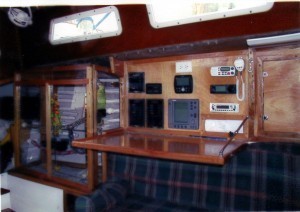
Short story–the bird died, I got rid of the cage, and I now plan to make the area into storage. Like everything else though, there are complications. The cage was made to be moved and I used the area behind the cage to run wires and make electrical connections. This past week I rewired the connections.
When we left Minnesota 8 years ago I did not have the time to connect the ham radio and the radar, so I intend to spend the next week hooking up these two items so we can use them while we are cruising. On top of that we are planning to buy a chartplotter this week and after the first of the year we'll buy solar panels, both of which I'll need to install.
It's true that we don't have to do all of this before we leave, but since I've been putting it off for eight years, I kind of figure it's time to get things in order. Besides, the units are out of date by now. I just hope everything is still in working order.
What about all of you out there, do you have projects you've been sitting on for a long time that you just don't seem to be able to get to?
Amazon.com Widgets
To purchase Mike's books for the Barnes and Noble Nook click here: Mike's Books for Nook.
To order Mike's books for all other e-Readers: Mike's books at Smashwords
Share on Facebook
December 17, 2011
A Cruising Mindset
As a society, we're incredibly goal oriented and that's not a bad thing – for society. It can be a really crappy thing for you however, if what you want to do in life doesn't fit with what society's goals are. For many of us, our presumed goal is to get south to warm sunshine, sandy beaches and palm trees.
So most cruisers race south, rushing past all manner of interesting places, regarding the trip south as a purgatory to be endured before entering the gates of paradise to the south. If you're planning on going south, my first piece of advice to you is this: STOP! SLOW DOWN!
Take it easy. You don't have to be anyplace. I know that's hard to fathom after so many years of having to be someplace, to do something, to be busy, always and eternally busy. Our previous lives have not conditioned us for what we are now doing.
You're cruising. Get into the mindset. Don't have a schedule, have plans. Or as one cruiser I know says: "Don't have plans, just have 'intentions'."
Most importantly, learn to enjoy every day, every minute, every single second. Sure, your goal is to get south, but there are many many worthwhile stops along the way to achieving that goal, and you want to experience as many as you can.
Let's say you're leaving from your usual cruising grounds. How many harbours, how many anchorages, are in your area that you have always wanted to explore? One? Two? Several dozen?
I'd bet it's a lot closer to several dozen, isn't it? So start your trip south early enough to drop your hook in these places, and start your adventure off right, learning and exploring new places. Might as well start early and be well practiced before you get too far south!
Actually, there are valid as opposed to metaphysical reasons to do this as well. Most of us cruise to the same old spots we've been stopping at for years. Stopping in at new places, you'll get practice docking and anchoring in new situations. That will help you develop skills you'll need as you get further south and into less 'civilized' cruising areas.
SImple observation is one of those skills. Because you're someplace new, you'll be paying far closer attention to the docks and anchorages you encounter and be actively thinking of how to successfully get on that dock, or anchored in the right spot. You'll start thinking anew of all those skills you learned years ago that have become rusty from being used in the same places and always in the same old way.
Nothing is the same anymore, or, to paraphrase what Dorothy said to Toto: "We're not in Kansas anymore…'
Another advantage to starting 'cruising', as opposed to 'traveling', early, is that you subject your boat (and yourself) to the stresses of cruising. Should your boat have issues you haven't discovered – mechanical, rigging, setup and so forth – that cause issues while cruising in new places, you'll discover the problems close enough to home to easily and comfortably deal with them. Should there be a piece of equipment you find yourself in need of, its necessity will become apparent, and be easily resolved while you're still close to home.
I can tell you, speaking from experience, that dealing with breakdowns and other issues while far from home can be – no, make that is – very challenging, if not maddeningly frustrating.
One of the biggest mistakes new cruisers make, and I'm speaking to the guys here, is rushing. It's a guy thing – gotta get there. The cure?Take one day every week to ten days and pull into a marina.
There are lots of valid reasons to do so: boat maintenance, laundry, bad weather and so on. But the reason I advise doing this is to give your spouse a break. Odds are, this trip is in fulfillment of the man's dreams and the better half is only going along because of that ring on her finger.
There's a saying in the cruising community, you might have heard it: If the admiral isn't happy, nobody's happy. So make sure this trip fulfills some of the goals of your partner.
What? You have no idea what she wants out of this trip? Or, worse yet, you think that she wants exactly what you want? Give your head a shake. In case you haven't noticed, women are different.
Share on Facebook


